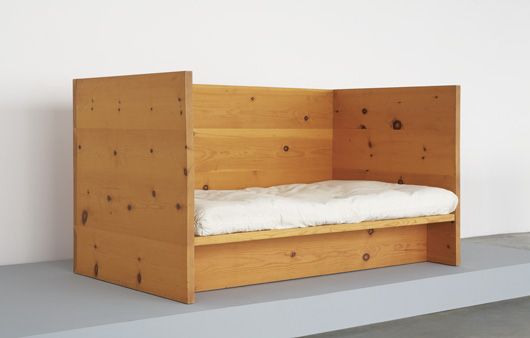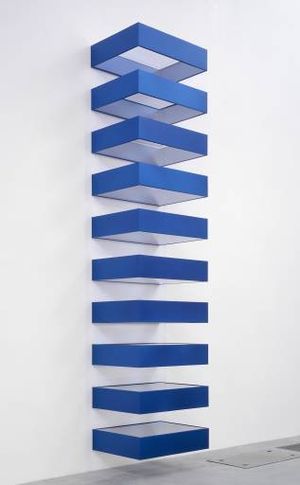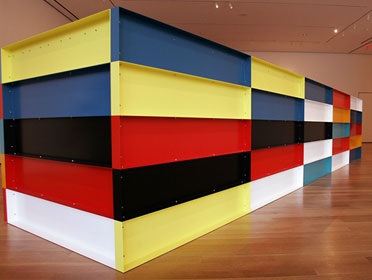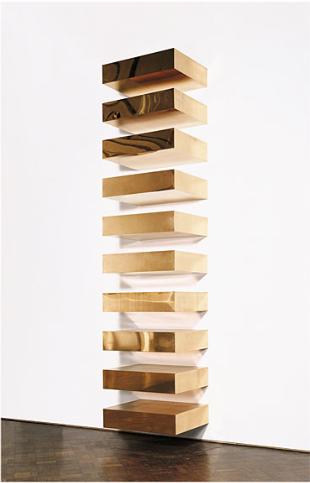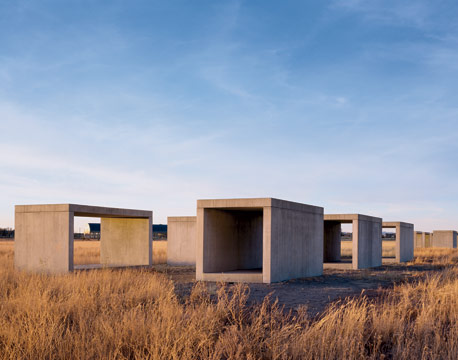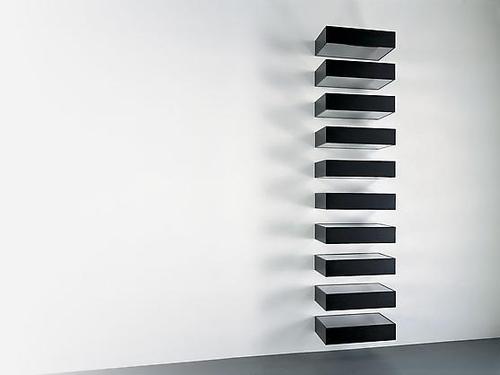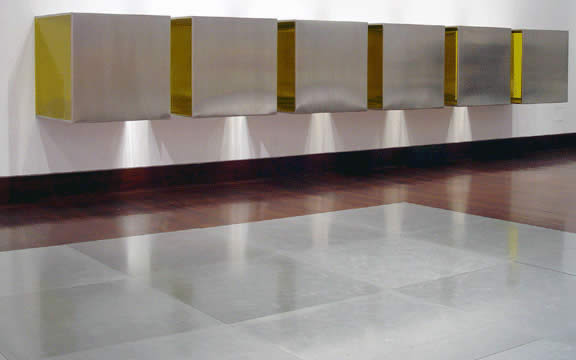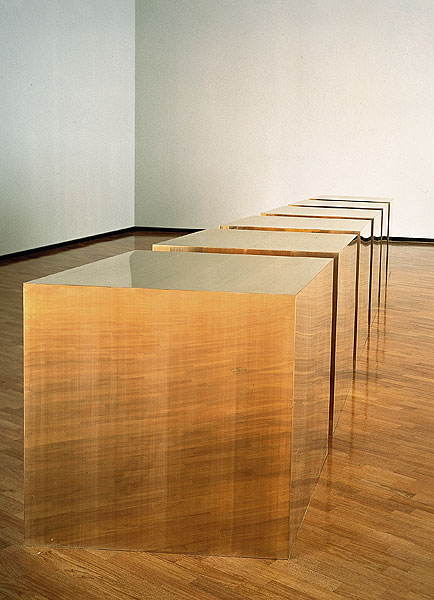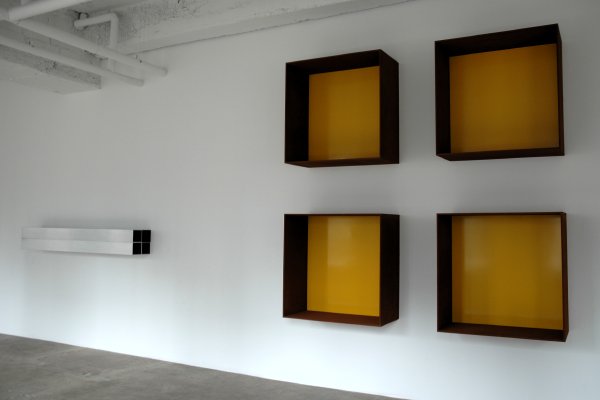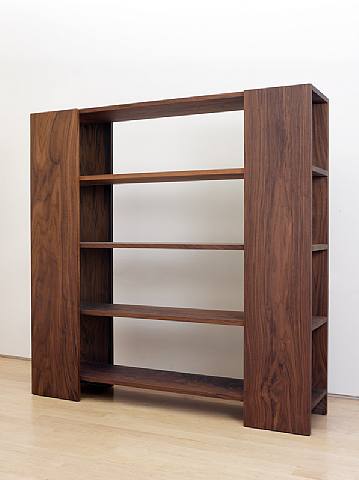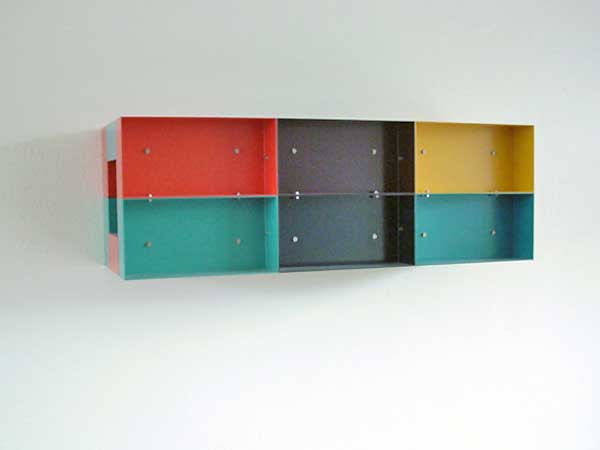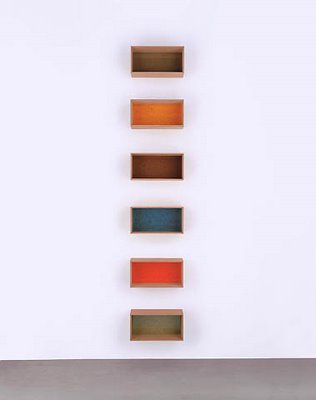<Back to Index>
- Sculptor Donald Clarence Judd, 1928
PAGE SPONSOR
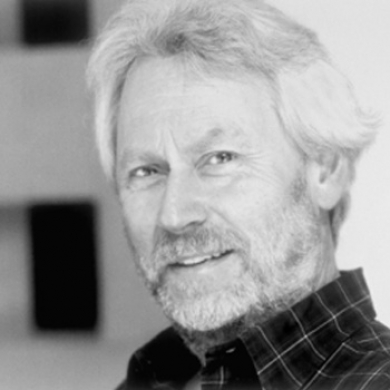
Donald Clarence Judd (June 3, 1928 – February 12, 1994) was an American artist associated with minimalism (a term he nonetheless stridently disavowed). In his work, Judd sought autonomy and clarity for the constructed object and the space created by it, ultimately achieving a rigorously democratic presentation without compositional hierarchy. It created an outpouring of seemingly effervescent works that defied the term "minimalism". Nevertheless, he is generally considered the leading international exponent of "minimalism," and its most important theoretician through such seminal writings such as "Specific Objects" (1964).
Judd was born in Excelsior Springs, Missouri. He served in the Army from 1946 - 1947 as an engineer and in 1948 began his studies in philosophy at the College of William and Mary, later transferring to Columbia University School of General Studies. At Columbia, he earned a degree in philosophy and worked towards a master's in art history under Rudolf Wittkower and Meyer Shapiro. Also at Columbia he attended night classes at the Art Students League of New York. He supported himself by writing art criticism for major American art magazines between 1959 and 1965. In 1968 Judd bought a five story cast iron building, designed by Nicholas Whyte in 1870, at 101 Spring Street for under $70,000, serving as his New York residence and studio. Over the next 25 years, Judd renovated the building floor by floor, sometimes installing works he purchased or commissioned from other artists.
In the late 1940s, Donald Judd began to practice as a painter. His first solo exhibition, of expressionist paintings, opened in New York in 1957. From the mid 1950s to 1961, as he explored the medium of the woodcut, Judd progressively moved from figurative to increasingly abstract imagery, first carving organic rounded shapes, then moving on to the painstaking craftsmanship of straight lines and angles. His artistic style soon moved away from illusory media and embraced constructions in which materiality was central to the work. He would not have another one person show until the Green Gallery in 1963, an exhibition of works that he finally thought worthy of showing.
By 1963 Judd had established an essential vocabulary of forms — ‘stacks’, ‘boxes’ and ‘progressions’ — which preoccupied him for the next thirty years. Most of his output was in freestanding "specific objects" (the name of his seminal essay of 1965 published in Arts Yearbook 8, 1965), that used simple, often repeated forms to explore space and the use of space. Humble materials such as metals, industrial plywood, concrete and color - impregnated Plexiglas became staples of his career. Judd's first floor box structure was made in 1964, and his first floor box using Plexiglas followed one year later. Also by 1964, he began work on wall - mounted sculptures, and first developed the curved progression format of these works in 1964 as a development from his work on an untitled floor piece that set a hollow pipe into a solid wooden block. While Judd executed early works himself (in collaboration with his father, Roy Judd), in 1964 he began delegating fabrication to professional artisans and manufacturers (such as the industrial manufacturers Bernstein Brothers) based on his drawings.
As he abandoned painting for sculpture in the early 1960s, he wrote the manifesto - like essay “Specific Objects” in 1964. In his essay, Judd found a starting point for a new territory for American art, and a simultaneous rejection of residual inherited European artistic values, these values being illusion and represented space, as opposed to real space. He pointed to evidence of this development in the works of an array of artists active in New York at the time, including Lucas Samaras, John Chamberlain, Jasper Johns, Dan Flavin, George Earl Ortman and Lee Bontecou. The works that Judd had fabricated inhabited a space not then comfortably classifiable as either painting or sculpture and in fact he refused to call them sculpture, pointing out that they were not sculpted but made by small fabricators using industrial processes. That the categorical identity of such objects was itself in question, and that they avoided easy association with well worn and over - familiar conventions, was a part of their value for Judd. He displayed two pieces in the seminal 1966 exhibit, "Primary Structures" at the Jewish Museum in New York where, during a panel discussion of the work, he challenged Mark di Suvero's assertion that real artists make their own art. He replied that methods should not matter as long as the results create art; a groundbreaking concept in the accepted creation process. In 1968, the Whitney Museum of American Art staged a retrospective of his work which included none of his early paintings.
In 1968, Judd bought a five story building in New York that allowed him to start placing his work in a more permanent manner than was possible in gallery or museum shows. This would later lead him to push for permanent installations for his work and that of others, as he believed that temporary exhibitions, being designed by curators for the public, placed the art itself in the background, ultimately degrading it due to incompetency or incomprehension. This would become a major preoccupation as the idea of permanent installation grew in importance and his distaste for the art world grew in equal proportion.
In the early 1970s his art increased in scale and complexity. He started making room sized installations that made the spaces themselves his playground and the viewing of his art a visceral, physical experience. Throughout the 1970s and 1980s he produced radical work that eschewed the classical European ideals of representational sculpture. Judd believed that art should not represent anything, that it should unequivocally stand on its own and simply exist. His aesthetic followed his own strict rules against illusion and falsity, producing work that was clear, strong and definite. Supported by a grant from the National Endowment for the Arts, the Northern Kentucky University commissioned Judd with a 9 feet aluminium sculpture that was unveiled in the middle of the school's campus in 1976. Another commission, Untitled (1984), a three part sculpture out of concrete with steel reinforcements, was installed at Laumeier Sculpture Park.
Judd started using plywood in the early 1970s, a material the artist embraced for its durable structural qualities, which enabled him to expand the size of his works while avoiding the problem of bending or buckling. Plywood had been the staple of his art earlier, but never unpainted. He later began using Cor-ten steel in the 1980s for a small number of large scale outdoor pieces, and by 1989 would create single and multi - part works with the material. The Cor-ten works are unique in that they are the only works the artist fabricated in Marfa. The artist began working with enamel on aluminum in 1984, when he had the Lehni factory in Switzerland bend thin sheets of the material — a process previously used to create furniture — for a temporary exhibition outdoor in the Merian Park, outside Basel. Judd’s work with enamel on aluminum greatly expanded his palette of industrial colors, which had previously been restricted to the colors of anodized metal and Plexiglas. Combining a wide range of colors, he used the material to create five large scale floor pieces and horizontal wall works in unique variations of color and size. Judd’s only known work in granite, an untitled Sierra White granite floor piece from 1978, measures 49 x 98 x 98". The structure is composed of two vertical slabs that rest on the floor, to which the bottom component is conjoined, and the ceiling of the structure extends to the outer edges of the vertical walls. Judd could not find a way to use more than two colors in his sculptures until his 1989 works made at the Lascaux factory in Brooklyn, New York.
In his later years, Judd also worked with furniture, design and architecture. The first furniture was designed in 1973, when he moved from New York to Marfa. Early furniture was made of rough pine but Judd continually refined the construction. Later he worked in sheet metal. The pieces included chairs, beds, shelves, desks and tables. Desk and Chair (both 1984), made of clear anodised aluminium and copper respectively, demonstrate Judd’s move from handcrafted forms to embracing methods of industrial manufacture. At his death, he was working on designs for a fountain commissioned by the city of Winterthur, Switzerland, in 1991, and a new glass facade for a railroad station in Basel, Switzerland.
In the early seventies Judd started making annual trips to Baja California with his family. He was very affected by the clean, empty desert and this strong attachment to the land would remain with him for the rest of his life. In 1971 he rented a house in Marfa, Texas, as an antidote to the hectic New York art world. From this humble house he would later buy numerous buildings and a 60,000 acre (243 km²) Ayala de Chinati Ranch (not open to the public), almost all carefully restored to his exacting standards; though rumored that much of the 'preserved' land has been sold. These properties and his building in New York are now maintained by the Judd Foundation.
In 1979, with help from the Dia Art Foundation, Judd purchased a 340 acre (1.4 km²) tract of desert land near Marfa, Texas, which included the abandoned buildings of the former U.S. Army Fort D. A. Russell. The Chinati Foundation opened on the site in 1986 as a non profit art foundation, dedicated to Judd and his contemporaries. The permanent collection consists of large scale works by Judd, sculptor John Chamberlain, light - artist Dan Flavin and select others, including David Rabinowitch, Roni Horn, Ilya Kabakov, Richard Long, Carl Andre and Claes Oldenburg and Coosje Van Bruggen. Judd's work in Marfa includes 15 outdoor works in concrete and 100 aluminum pieces housed in two painstakingly renovated artillery sheds.
Judd taught at several academic institutions in the United States: The Allen - Stevenson School (1960s), Brooklyn Institute of Arts and Sciences (1962 – 64); Dartmouth College, Hanover (1966); and Yale University, New Haven (1967). In 1976 he served as Baldwin Professor at Oberlin College in Ohio. Beginning in 1983, he lectured at universities across the United States, Europe and Asia on both art and its relationship to architecture. During his lifetime, Judd published a large body of theoretical writings, in which he rigorously promoted the cause of Minimalist Art; these essays were consolidated in two volumes published in 1975 and 1987.
The Panoramas Gallery organized his first solo exhibition in 1957. The Whitney Museum of American Art, New York, organized the first retrospective of his work in 1968. During this decade, the artist received many fellowships, among them a grant from the John Simon Guggenheim Memorial Foundation in 1968. In 1975 the National Gallery of Canada, Ottawa, organized a Judd exhibition and published a catalogue raisonné of Judd’s work. He participated in his first Venice Biennale in 1980, and in Documenta, Kassel, in 1982.
In 1987, Judd was honored by a large exhibition at the Van Abbemuseum, Eindhoven; this show traveled to Düsseldorf, Paris, Barcelona and Turin. The Whitney Museum organized a second, traveling retrospective of his work in 1988. Another major European survey was mounted by Tate Modern in 2004.
Judd's work is represented in collections including: the Museum für angewandte Kunst, Vienna; the Tehran Museum of Contemporary Art, Iran; the Hallen für Neue Kunst Schaffhausen, Switzerland; the Migros Museum für Gegenwartskunst, Zurich; the Tate Modern and the Tate Britain, London; the Museum of Contemporary Art, Chicago; the Walker Art Center, Minneapolis; the Storm King Art Center, Mountainville, New York; the Solomon R. Guggenheim Museum and The Museum of Modern Art, New York; Dia: Beacon, New York; the San Francisco Museum of Modern Art; and the Hirshhorn Museum and Sculpture Garden, Washington.
Prices for Judd's works first peaked in 2002, when a group of six Plexiglas boxes sold for $4.2 million. The largest of Judd's stacks, comprising 10 galvanized iron elements with ten - inch intervals, Untitled, 1977 (77-41 BERNSTEIN) (1977), fetched $9,8 million at Christie's in 2007. Judd's ten - unit sculpture Untitled, 1968 (DSS 120) made of stainless steel and amber Plexiglas was sold for $4.9 million at Christie's New York in 2009.
The Leo Castelli Gallery, New York, represented the artist from 1965 to 1985. Judd then worked with Paula Cooper Gallery, New York, where he had a number of solo shows, and PaceWildenstein, which represented him through the end of his life. Judd's work has been represented - through the Judd Foundation - by David Zwirner since 2010.
Originally conceived in 1977, and created in 1996, the Judd Foundation was formed in order to preserve the work and installations of Judd in Marfa, Texas, and at 101 Spring Street in New York. In 2006, the Judd Foundation decided to auction off about 36 of his sculptures in order to cover the costs of refurbishing the foundation's buildings. The foundation board requested one of its members, publisher Richard Schlagman, to get Christie's and Sotheby's to submit proposals for the sale of a group of works. Christie's offered a reported $21 million guarantee and agreed to display the consigned work for five weeks in New York on the 20th floor of the Simon & Schuster building. Concerns that the sale would have an adverse effect on the market proved unfounded and the exhibition itself won an AICA award for "Best Installation in an Alternative Space" for 2006. The $20 million in proceeds from the sale went into an endowment that enable the Foundation to fulfill its mission, supporting the 16 permanent installations that are located at 101 Spring Street in New York City and Marfa, Texas. Marianne Stockebrand, director of the Chinati Foundation, resigned from her post on the Judd Foundation’s board partly in protest of the auction.
Judd married dancer Julie Finch in 1964 (later divorced) and fathered two children, son Flavin Starbuck Judd and daughter Rainer Yingling Judd. He died in Manhattan of Non - Hodgkin's lymphoma in 1994. He had homes in Manhattan, Marfa, Texas, and Kussnacht am Rigi, Switzerland.
